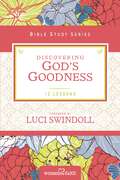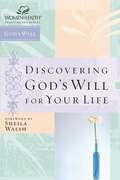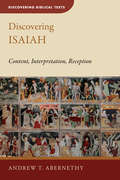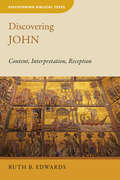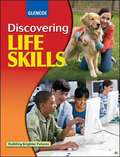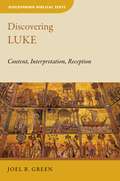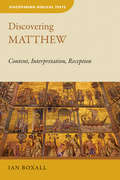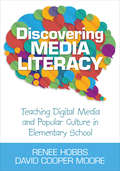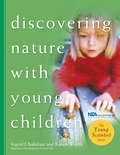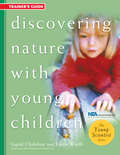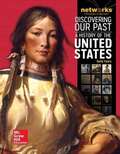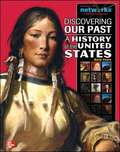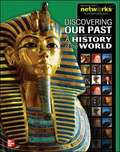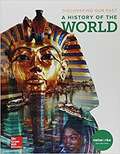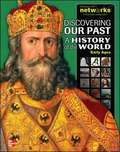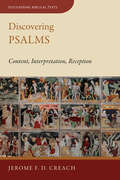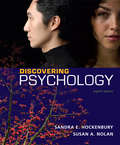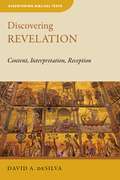- Table View
- List View
Discovering God's Goodness (Women of Faith Study Guide Series)
by Luci Swindoll Margaret Feinberg Women Of FaithKing David encouraged us to "taste and see that the Lord is good" (Psalm 34:8). Our heavenly Father serves up a feast of His truth, grace, peace, and freedom to us in abundance--and invites us to enjoy it! When we discover His goodness and truly "count our blessings," it changes our entire outlook on life. In Discovering God's Goodness, you will explore what the Bible has to say about God's grace and what the Lord did to rescue you from the prison of sin. You will uncover how God's unmerited favor made it possible for you to be forgiven, redeemed, and restored so you could experience eternal life with Him. This is a blessing none of us deserves--but God gives it to us anyway if we accept Him and live our lives for His glory. The Women of Faith® Bible Studies provide intriguing insights into topics that are relevant to women's lives today. Each guide includes twelve weeks of study, down-to-earth illustrations, and reflections to help you move the truth from your head to your heart. A leader's guide for use with small groups is also included.
Discovering God's Will for Your Life (Women of Faith Study Guide Series)
by Sheila WalshThese topical guides will deal with issues that women wrestle with today: God's Will, Living in Christ, Prayer, and Worry.Reaching an audience across race, socio-economic, denominational, and age boundaries, these guides will enhance the lives of women in America as they empower them in their weekly devotions. The study guides can be used for both individual and group settings.Women are asking good questions about their faith. With our study guides, we want to join them in their quest for knowledge and lead them in finding the answers they are seeking.
Discovering Isaiah: Content, Interpretation, Reception (Discovering Biblical Texts (DBT))
by Andrew T. AbernethyThis concise introduction to the interpretation of the book of Isaiah encourages in-depth study of the text and deliberate grappling with related theological and historical questions by providing a critical assessment of key interpreters and interpretative debates. It draws on a range of methodological approaches (author-, text-, and reader-centered) and reflects the growing scholarly attention to the reception history of biblical texts, increasingly viewed as a vital aspect of interpretation rather than an optional extra.
Discovering John: Content, Interpretation, Reception (Discovering Biblical Texts (DBT))
by Ruth B. EdwardsStudent-friendly introduction to the Gospel of John This up-to-date introduction to John's Gospel is the first volume in the Discovering Biblical Texts series, which encourages students to engage deeply with the biblical writings by alerting them to key issues and questions raised by the text. In Discovering John Ruth Edwards covers the structure, content, theological concerns, key interpretive debates, and historical reception of the Gospel of John. Does John still have meaning for the church and contemporary society? Does it need to be reinterpreted for today's world? Is it anti-Semitic? Edwards expertly guides readers through these questions and others, helping those interested in this provocative, sometimes enigmatic Gospel to discover the answers for themselves.
Discovering John: Content, Interpretation, Reception (Discovering Biblical Texts (DBT))
by Ruth B. EdwardsStudent-friendly introduction to the Gospel of John This up-to-date introduction to John's Gospel is the first volume in the Discovering Biblical Texts series, which encourages students to engage deeply with the biblical writings by alerting them to key issues and questions raised by the text. In Discovering John Ruth Edwards covers the structure, content, theological concerns, key interpretive debates, and historical reception of the Gospel of John. Does John still have meaning for the church and contemporary society? Does it need to be reinterpreted for today's world? Is it anti-Semitic? Edwards expertly guides readers through these questions and others, helping those interested in this provocative, sometimes enigmatic Gospel to discover the answers for themselves.
Discovering Luke (Discovering Biblical Texts (DBT))
by Joel B. GreenThis interpretation of Luke encourages in-depth study of the text and genuine grappling with the theological and sociohistorical questions it raises. It draws on a range of methodological interests (author-, text-, and reader-centered) as complementary rather than mutually exclusive ways of understanding the text. It also recognizes the importance of the reception history of biblical texts, increasingly viewed as a vital aspect of interpretation rather than an optional extra. Throughout Discovering Luke, Joel Green gives readers strategies for reading the Gospel of Luke and guides them through Luke&’s world in its historical, ideological, political, and economic contexts. Green reviews key issues raised by the Gospel and connects these issues to questions of how Luke should be interpreted today.
Discovering Matthew: Content, Interpretation, Reception (Discovering Biblical Texts (DBT))
by Ian BoxallStudent-friendly introduction to the Gospel of Matthew In this introduction to the story that Matthew tells, Ian Boxall deftly guides readers through the sources, origins, themes, and main characters of the first Gospel. The book&’s short chapters enable coverage of a wide range of topics, presenting the issues and scholarly debates surrounding the Gospel of Matthew in an accessible yet nuanced manner. Like the first Discovering Biblical Texts volume, on the Gospel of John, Discovering Matthew offers a guide to key issues and questions raised by the text to enable readers to come to their own conclusions. Encouraging in-depth study of the text and genuine grappling with pertinent theological and historical questions, this book is an ideal introduction to the interpretation of Matthew.
Discovering Matthew: Content, Interpretation, Reception (Discovering Biblical Texts (DBT))
by Ian BoxallStudent-friendly introduction to the Gospel of Matthew In this introduction to the story that Matthew tells, Ian Boxall deftly guides readers through the sources, origins, themes, and main characters of the first Gospel. The book&’s short chapters enable coverage of a wide range of topics, presenting the issues and scholarly debates surrounding the Gospel of Matthew in an accessible yet nuanced manner. Like the first Discovering Biblical Texts volume, on the Gospel of John, Discovering Matthew offers a guide to key issues and questions raised by the text to enable readers to come to their own conclusions. Encouraging in-depth study of the text and genuine grappling with pertinent theological and historical questions, this book is an ideal introduction to the interpretation of Matthew.
Discovering Media Literacy: Teaching Digital Media and Popular Culture in Elementary School
by Renee Hobbs David Cooper MooreGive digital kids a voice! Today’s kids are digital natives, but what’s the best way to help them become empowered and responsible communicators across different media? Discover insights and strategies specific to reaching children ages 5-12 in this guide from a nationally-acclaimed media literacy program. Readers will find: Thought-provoking lesson plans that reach students of all backgrounds and abilities Use of a wide range of technology tools, including the Internet, video, and mobile apps, An emphasis on online safety and development of essential critical thinking skills Materials for teacher professional development
Discovering Music
by R. Larry Todd<P>Discovering Music offers the depth, breadth, and context that students need, in a concise format that is visually appealing.<P> Written to inspire students to connect intellectually and emotionally with music from the Western canon and beyond, the text is supported by a suite of online ancillaries, including interactive listening maps, videos and animations, an instructor's manual, PowerPoint presentations, a computerized test bank, and an interactive eBook.<P> Following the established sequence for Music Appreciation texts, the book opens with an introduction to the musical elements; the instruments of the orchestra; and a discussion of how to listen to music.<P> Then, each musical era is highlighted in individual parts, with a brief introduction to the key composers and developments that occurred in music and the related arts.<P> Individual chapters focus on key figures or movements, with detailed Listening Maps offering unique guidance to students on how and why to listen to each work. In between each part, Musical Journeys allow students to make connections with non-Western musical traditions.
Discovering Nature with Young Children
by Karen Worth Ingrid ChalufourField-tested across the country, this comprehensive curriculum expands and extends the role science has traditionally played in the early childhood classroom. The first in a new series, Discovering Nature with Young Children explores the wide-ranging elements that make up the natural world around us. The curriculum replaces simple fact-feeding practices with the development of long-term scientific reasoning, including literacy skills and numeracy skills, such as hypothesis, inference, prediction, and estimation.
Discovering Nature with Young Children: Trainer's
by Karen Worth Ingrid ChalufourField-tested across the country, this comprehensive curriculum expands and extends the role science has traditionally played in the early childhood classroom. The first in a new series, Discovering Nature with Young Children explores the wide-ranging elements that make up the natural world around us. The curriculum replaces simple fact-feeding practices with the development of long-term scientific reasoning, including literacy skills and numeracy skills, such as hypothesis, inference, prediction, and estimation. A companion to the curriculum, this trainer's guide serves as an indispensable handbook for trainers and administrators interested in introducing staff to the curriculum--from planning to implementation. Special sections outline the curriculum and introduce scientific reasoning to adults, and eight workshops detail the complete curriculum for staff members. The guide also includes strategies for supporting teachers over time through mentoring and guided discussions.
Discovering Our Past: A Brief Introduction to Archaeology, Sixth Edition
by Robert J. Sharer Wendy AshmoreThis book briefly introduces students to contemporary archaeology's techniques, methods, and theoretical frameworks. Adopted and streamlined from the authors' hardcover text, Archaeology: Discovering Our Past, this book provides students with various archaeological perspectives through comprehensive information on contemporary methods and theories. Illustrative examples and case studies represent a temporal and geographic balance of both Old and New World sites.
Discovering Our Past: A History of the United States - Early Years (The American Journey)
by McGraw HillDiscovering Our Past: A History of the United States-Early Years, Student Edition
Discovering Our Past: A History of the United States, Early Years
by James M. Mcpherson Joyce Appleby Alan Brinkley Donald A. Ritchie Albert S. BroussardBring the people, issues, and events of yesterday to life for the students of today with the first truly integrated print and digital curriculum for Middle School U. S. History. McGraw-Hill networks: A Social Studies Learning Systemcombines print resources grounded in solid pedagogy with a full suite of teaching and learning tools for a flexible, customized learning experience. Focus on theEssential Questionswith an accessible student text built aroundEnduring Understandingand NCSS Standards Put students in the middle of the action withThe Story Matterschapter openers,Biographyfeatures,Step Into Placemaps andStep Into Timetimelines Maximize comprehension with built-inreading strategies,vocabulary support,Visual Literacyactivities, andGuided Questions Build critical thinking and historical analysis skills withThinking Like a Historian,It Matters Because,What Do You Think, andConnections to Today Customize the learning experience with differentiated instruction, leveled reading, customizable assessments and worksheets, and flexible online learning tools
Discovering Our Past: A History of the World
by Jackson J. SpielvogelDiscovering Our Past: A History of the World connects today's students to the stories of our past with the first truly integrated print and digital middle school world history curriculum. McGraw-Hill networks: A Social Studies Learning System combines print resources grounded in solid pedagogy with a full suite of teaching and learning tools for a flexible, customized learning experience. Focus on the Essential Questions with an accessible student text built around Enduring Understanding and NCSS Standards Bring the stories of the ages to life with with The Story Matters chapter openers, Biography features, Step Into Place maps and Step Into Time timelines Maximize comprehension with built-in reading strategies, vocabulary support, Visual Literacy activities, and Guided Questions Build critical thinking and historical analysis skills with Thinking Like a Historian, It Matters Because, What Do You Think, and Connections to Today Customize the learning experience with differentiated instruction, leveled reading, customizable assessments and worksheets, and flexible online learning tools
Discovering Our Past: A History of the World
by Jackson J. SpielvogelDiscovering Our Past: A History of the World connects today's students to the stories of our past with the first truly integrated print and digital middle school world history curriculum. McGraw-Hill networks: A Social Studies Learning System combines print resources grounded in solid pedagogy with a full suite of teaching and learning tools for a flexible, customized learning experience. Focus on the Essential Questions with an accessible student text built around Enduring Understanding and NCSS Standards Bring the stories of the ages to life with with The Story Matters chapter openers, Biography features, Step Into Place maps and Step Into Time timelines Maximize comprehension with built-in reading strategies, vocabulary support, Visual Literacy activities, and Guided Questions Build critical thinking and historical analysis skills with Thinking Like a Historian, It Matters Because, What Do You Think, and Connections to Today Customize the learning experience with differentiated instruction, leveled reading, customizable assessments and worksheets, and flexible online learning tools
Discovering Our Past: A History of the World
by McGraw-Hill EducationDiscovering Our Past: A History of the World, Student Edition
Discovering Our Past: A History of the World, Early Ages
by Jackson J. SpielvogelConnect to core World History content with an accessible, student-friendly text built on the principles of Understanding by Design.
Discovering Our Past: A History of the World, Early Ages (Student Edition)
by Jackson J. SpielvogelDiscovering Our Past: A History of the World connects today's students to the stories of our past with the first truly integrated print and digital middle school world history curriculum. McGraw-Hill networks: A Social Studies Learning System combines print resources grounded in solid pedagogy with a full suite of teaching and learning tools for a flexible, customized learning experience. Focus on the Essential Questions with an accessible student text built around Enduring Understanding and NCSS Standards Bring the stories of the ages to life with with The Story Matters chapter openers, Biography features, Step Into Place maps and Step Into Time timelines Maximize comprehension with built-in reading strategies, vocabulary support, Visual Literacy activities, and Guided Questions Build critical thinking and historical analysis skills with Thinking Like a Historian, It Matters Because, What Do You Think, and Connections to Today Customize the learning experience with differentiated instruction, leveled reading, customizable assessments and worksheets, and flexible online learning tools
Discovering Psalms: Content, Interpretation, Reception (Discovering Biblical Texts (DBT))
by Jerome F CreachThis compact introduction to the interpretation of the book of Psalms encourages in-depth study of the text and genuine grappling with related theological and historical questions by providing a critical assessment of key interpreters and interpretative debates. It draws on a range of methodological approaches (author-, text-, and reader-centered) and reflects the growing scholarly attention to the reception history of biblical texts, increasingly viewed as a vital aspect of interpretation rather than an optional extra.
Discovering Psychology: Test Bank
by Sandra E. Hockenbury Susan A. NolanSandra Hockenbury and new coauthor Susan Nolan’s remarkable textbook is grounded in the belief that all kinds of students can develop a real understanding of psychology and lasting scientific literacy. <P><P> The authors act on that belief by using relatable personal stories to communicate the concepts of psychological science (and the process of science itself), and by presenting important research in a clear not oversimplified way. <P><P> Hockenbury and Nolan also take full advantage of online learning, creating activities in LaunchPad that have students thinking about psychology as scientists do. <P><P>New co-author, Susan Nolan of Seton Hall University was recently designated a Master Teacher by the Society for Teaching Psychology. She regularly gives talks about incorporating scientific literacy into the introductory course and across the psychology curriculum.
Discovering Revelation: Content, Interpretation, Reception (Discovering Biblical Texts (DBT))
by David A. deSilvaThe book of Revelation has been received over the past several centuries with both fascination and aversion, but one thing is certain: it has profoundly shaped Christian history and culture. And the way it has shaped history and culture has been determined, in large part, by how the book has been variously—and sometimes irresponsibly—interpreted. David A. deSilva addresses the interpretation and reception-history of Revelation in this compact, up-to-date, and student-friendly introduction to the book of Revelation, focusing on its structure, content, theological concerns, key interpretive debates, and historical reception. Discovering Revelation draws on a range of methodological approaches (author-, text-, and reader-centered) as complementary rather than mutually exclusive ways of interpreting the text. DeSilva pays special attention to defining features of Revelation, such as its use of sequences of seven as a major structuring device, its nonlinear plotline, and its deployment of contrast and parody. As deSilva writes, &“A text as rich and multidimensional as Revelation calls for its readers to adopt a rich and multidimensional approach that draws upon a variety of interpretative angles and skills.&”.
Discovering Romans: Spiritual Revival for the Soul
by Mike Abendroth S. Lewis JohnsonDiscovering Romans: Spiritual Revival for the Soul is a popular level guide by outstanding Bible teacher S. Lewis Johnson that opens up the motivating truths found in the apostle Paul’s powerful letter to the Romans. Anyone hungry to grow in practical understanding of Scripture will profit from Johnson’s rich teaching that stimulates both mind and emotions. This beloved pastor and professor works through the text engagingly, providing both clarifying insights and life applications along the way. Each chapter ends with reflection questions, making this volume useful not only for individual reading (or preparation for teaching) but also in small group Bible studies. John MacArthur once said, “Through the years I have listened to the preaching of S. Lewis Johnson far more than any other preacher.” Reading through this volume will be a soul-reviving experience.
